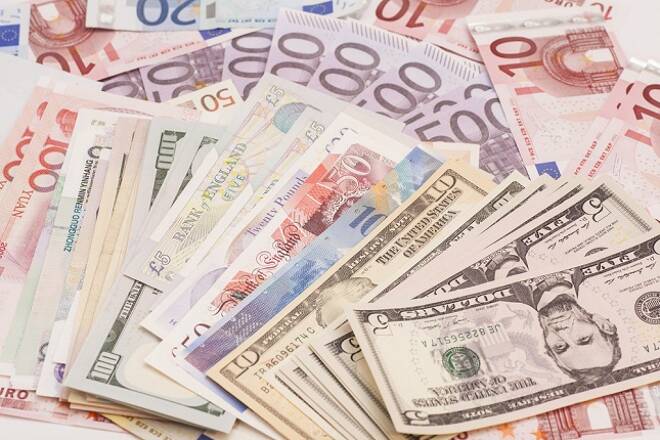Advertisement
Advertisement
EUR/USD Daily Technical Analysis for May 25, 2017
By:
The EUR/USD rebounded from session lows, following softer than expected housing data released in the U.S. on Wednesday. Confidence in German continues to
The EUR/USD rebounded from session lows, following softer than expected housing data released in the U.S. on Wednesday. Confidence in German continues to rise, but the ECB was on the tape, speaking out of both sides of their mouths, leaving traders confused about how the central bank will handle their message following their June monetary policy meeting.
The EUR/USD is forming a bull flag pattern which is a pause that refreshes. Prices formed a doji day which occurs when the open and the close are the same level. This reflects market indecision. Support is seen near the 10-day moving average at 1.1094, while resistance is seen near the November 8, U.S. election day highs, at 1.1299. A break of this level would lead to a test of the August 2016 highs at 1.1365. Momentum has turned neutral as the MACD (moving average convergence divergence) index is printing in the black, but the MACD histogram is edging lower reflecting decelerating positive momentum, which reflects consolidation.
German Ifo Service Was Steady in May
German Ifo services confidence steady at 108.0 in May. The current conditions indicator dropped back, but the expectations index jumped higher to 101.4 from 100.0 in the previous month. This is the first improvement in the expectations index since October last year, which adds to other confidence indicators suggesting the German recovery remains on track and growth is likely to stay robust in Q2.
German Consumer Confidence Rises
German consumer confidence rises to 10.4, with the projected June reading from 10.2 in May. A slightly stronger than anticipated number, which suggests the French election outcome not only lifted business, but also consumer sentiment. The breakdown, which is only available until May, shows a marked rise in business cycle expectations. Income expectations also picked up and the willingness to save dipped further into negative territory.
The ECB was on the Tape
Mario Draghi said there was no reason to deviate from policy guidance, stressing that QE could have more negative consequences than negative interest rates. The comments confirm again that no matter in what way the ECB will tweak the forward guidance in June, the sequence of exit steps, which currently suggests that rates will rise only after QE has been phased out, will remain in place. Draghi admitted that the macroeconomic climate is improving and the Eurozone witnessing an increasingly solid recovery, but added, that underlying inflation pressures remain subdued.
ECB’s Vasiliauskas said that June right time to discuss guidance. The council member said the central bank is moving to the moment when “there is a need for internal discussions regarding forward guidance” and the June 8 policy meeting is the “right time and the right place”. He said it would be “very logical” to first discuss the balance of risks, then forward guidance and outlook for the bond purchase program and only then rates. So even if he recently suggested that the ECB could move to a tightening bias next month to lay the ground on exit step announcements in September, he doesn’t seem to advocate a change in the sequence of exit steps.
The ECB’s Constancio said that the central bank is aware that the economy is improving, but added that the central bank must be cautious about prematurely withdrawing the stimulus. The ECB’s Vice President rarely strays away from Draghi’s view and with chief economist Praet, who prepares the opening address at the ECB’s council meeting, also urging caution with regard to a change in language and guidance, it seems the top three at the Executive Board are still resisting any change that would lay the ground for tapering ahead.
Existing Home Sales Dropped
Tight supply of existing homes is taking its toll on sales. Prices continue to get buoyed, as inventories dropped to multi-year lows. On Wednesday, the National Association of Realtors said that existing home sales declined 2.3% to an annual rate of 5.57 million units last month. Despite the decline, April’s sales pace was the fourth highest over the past year. March’s sales pace was revised down to 5.70 million units, which was still the highest level since February 2007.
U.S. MBA mortgage market index rose 4.4%, alongside a 0.8% dip in the purchase index and a 10.5% jump in the refinancing index for the week ended May 19. The average 30-year fixed mortgage rate sank 6 basis points to 4.17%. The housing sector in April took a knock with yesterday’s 11.4% drop in new home sales and housing starts sank 2.6% last week, while existing home sales was lower by 2.3%.
About the Author
David Beckerauthor
David Becker focuses his attention on various consulting and portfolio management activities at Fortuity LLC, where he currently provides oversight for a multimillion-dollar portfolio consisting of commodities, debt, equities, real estate, and more.
Did you find this article useful?
Latest news and analysis
Advertisement
